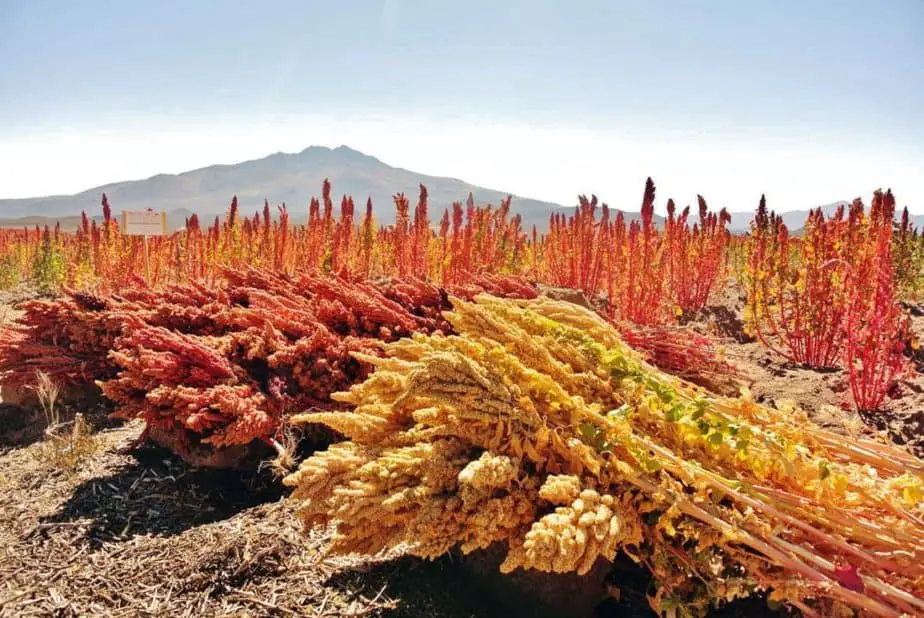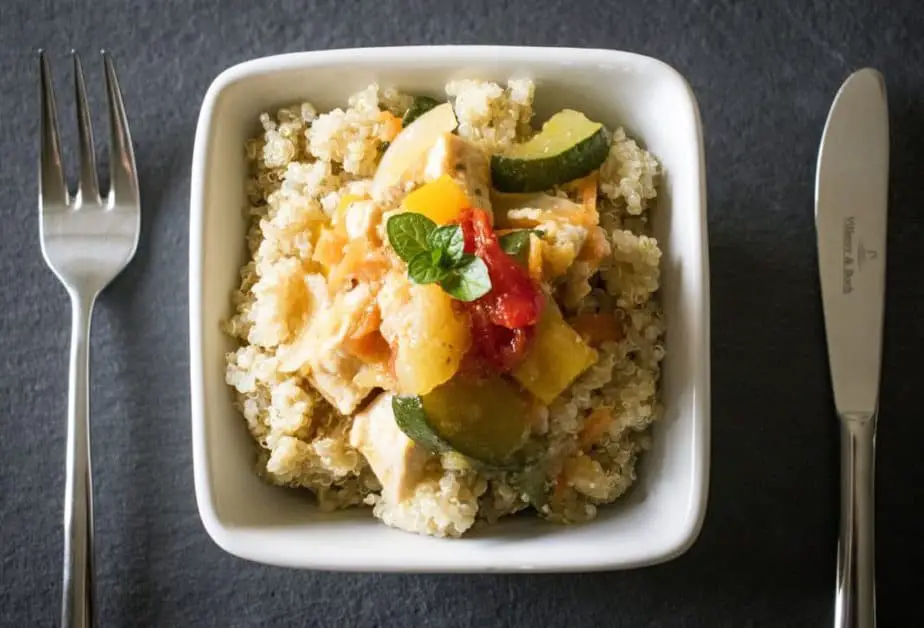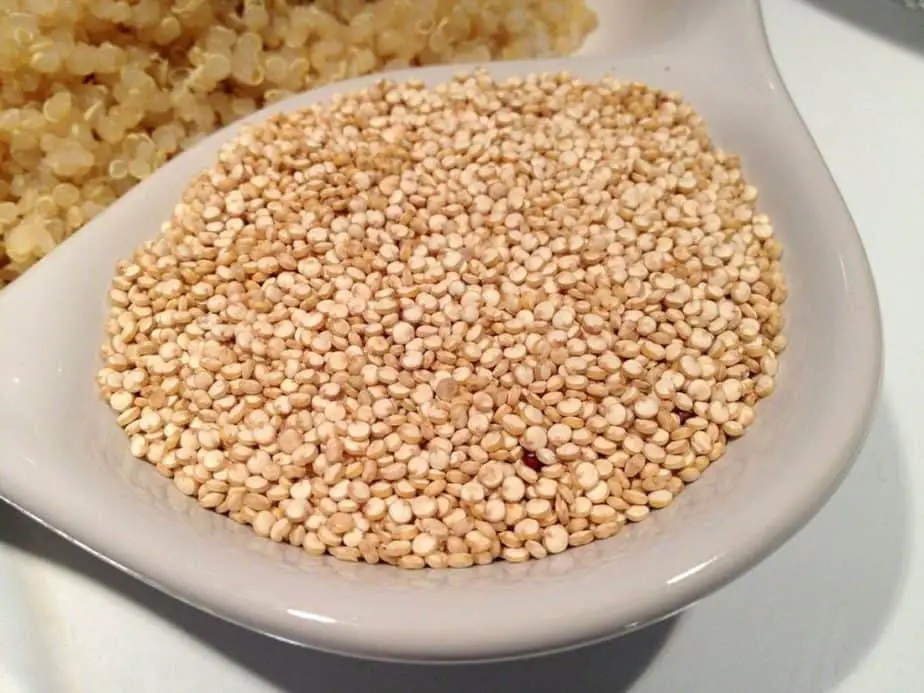Quinoa has become a well-known “superfood” around the world, so if you’re curious if it was originally from India… then you’d be mistaken.
Quinoa didn’t originally come from India, instead, it has been grown in South America for thousands of years. However, in recent years India’s farmers did produce 10,000 tons of quinoa annually, which is 11% of what South America grows (90,000 tons a year).
Quinoa has gotten a lot of publicity recently because it is a very healthy seed. It is one of the most protein-rich seeds (14 to 18%) with a complete profile of essential fatty acids. It is also wheat and gluten-free, and has a low glycemic index. Quinoa is also high in potassium, iron, magnesium, and fiber.
Eating a bowl of quinoa each day reduced your chances of premature death from cancers, diabetes, heart disease, and respiratory diseases by 17%.
The Harvard Public School of Health
But quinoa is usually eaten in salads, which is not a common dish in India. Although Indian’s do eat a lot of rice and lentils, which can be substituted for quinoa. As the food gains popularity as a “superfood” many Indian farmers are growing it to meet the growing demand.
If you’re curious about this “grain,” read on…
Where Does Quinoa Come From?

Quinoa is mostly grown in the Andean region in South America. Peru and Bolivia are the largest producers of quinoa.
Quinoa has a long history in the area as well. The Incans called it the “mother grain” and it was the “gold of the Incas.” They even worshiped it in religious ceremonies and believed it gave stamina to their warriors.
When the Spanish invaded their empire, they declared quinoa a false idol and burned fields and fields of it. They almost destroyed all the evidence of quinoa, however, some seeds were spared and in the 1980s, two Americans rediscovered this seed and started growing it in Colorado.
Quinoa is often mispronounced like “kwuh-NO-uh” or “KWIN-wah.” Instead, it is pronounced like “KEEN-wah.”
Harvard School of Public Health
According to the United Nations, 70,000 tons of quinoa came from the Andean region in 2009. That number went up to 90,000 tons of quinoa in 2015, according to a study done on the global quinoa production 2010-2017.
However, India has started to grow quinoa as well. Rajasthan is the largest producer with 6,000 tons. Andra Pradesh and Uttarakhand are also big producers of quinoa. But the entire country of India produces less than 10,000 tons, which is only about 11% of what is grown in South America.
According to a paper in the Journal of Food Reviews International, there are many different varieties of seeds of quinoa. While traditionally grown at high-altitudes, it can now grow at sea level. It can thrive in cold climates or subtropical conditions. However, it does need at least 150 days for the seeds to harvest, which is difficult in colder climates.
Quinoa has a lot of potential in India because it is such a nutritious crop that can be grown in a wide variety of conditions. It has higher protein and fewer carbohydrates than the traditionally used rice.
Is Quinoa Better Than Wheat?
Quinoa and wheat have about the same about of protein. However, quinoa has a more complete set of amino acids, making it a more high quality protein. Quinoa is gluten-free, although it can sometimes be harvested at similar factories making it higher risk.
Is Quinoa Better Than Indian Grains?

Indian grains like amaranth and millet are similar to quinoa and might be a better choice for you.
Amaranth, also called rajgira or ramdana, is also rich in fiber and protein. Similar to quinoa it is not a grain, but a seed, so it is often called a pseudocereal.
Similar to quinoa, amaranth is gluten-free and has a lot of antioxidants. It is also rich in manganese, magnesium, phosphorus and iron.
There is also a wide range of local Indian millets, one of the most common being finger millet or ragi. The millets are also high in fiber, B6, niacin, and folic acid. They are also rich with beta-carotene, calcium, zinc, magnesium, iron, and potassium.
Another benefit of eating amaranth and local millets like ragi are it would reduce your ecological footprint. Since quinoa is often still imported from South America, it may be more environmentally friendly to eat these similar seeds.
However, India is growing quinoa in larger quantities and you may be able to find brands that are grown here.
How Is Quinoa Grown In India?

The quinoa grown in India tends to be much darker, than the seeds in other countries. Quinoa can be white, but also purple, green, and red.
Quinoa looks like a grain but it is actually a seed. It is more similar in genetics to spinach than it is to wheat. The plants grow about 3 to 5 feet in height with deep roots.
It can be difficult for Indian farmers to get seeds. Most seeds are imported from Mexico or South America. If Indian farmers can produce their own seeds, then they can ramp up their commercial farming of quinoa.
According to Agrifarming.in, Quinoa can be grown in poor soils, as long as it’s not entirely clay. Sandy loam is the most compatible soil with quinoa, which has a lot of potash but is low in nitrogen, phosphate, and humus. Tamil Nadu, Odisha, Madhya Pradesh, Karnataka, Jharkhand, and Maharashtra all have this type of soil.
Quinoa could be a perfect crop in hard to farm areas, such as the Himalayas as well.
Quinoa is a rain-fed crop and doesn’t require irrigation as long as there are regular rains. Ideal temperatures are around 20 degrees Celsius, yet quinoa is hardy and can grow in temperatures as high as 39 degrees Celsius and as low as -8 degrees Celsius.
After the United Nations declared 2013 the “International Year of Quinoa,” India started to produce it much quicker and many farmers made a lot of money in 2015.
However, in 2018, Hindustan Times reported that there was a drop in prices worldwide as the supply of quinoa significantly shot up, exceeding the demand so that many farmers had a difficult time selling their crops.
What is Quinoa Called in India?

Chenopodium quinoa is the scientific name for quinoa, and in India, the Chenopodium species is called “bathua.”
However, bahtua is the name for the goosefoot plant and quinoa is the seed of that plant.
Quinoa is in also in the same family as amaranth, which is a local grain in India.
Amaranth is a great alternative to quinoa as well because it has more protein and can be found for more reasonable prices.
Where Can You Buy Quinoa in India?

In big cities like Mumbai, Kolkata, Delhi and Bengaluru, health food stores and restaurants have been offering quinoa-based dishes.
You can now find quinoa cookies, protein bars, idlis, poha mix, muesli, chapati flour, and pasta.
You can even find ice cream and beer made from quinoa.
Quinoa can be difficult to find in most traditional grocery stores, but you can easily find it in health food stores in big cities. You can also find it on Amazon. Companies like Kilaru Naturals and Nourish You sell it for reasonable prices, albeit higher than rice or lentils.
I found 926 results for “quinoa” when searching it on Amazon in India. Although the prices are more than lentils or rice, you can find brands like Fitness Mantra selling it with plenty of 4+ star reviews (click the link to check the price).
What Are The Best Ways To Cook Quinoa?
Quinoa can be eaten in many ways. Many people simply substitute it for dal, rice or pasta.
You can use it to make flour, soup, breakfast dishes, biscuits, bread and even alcohol.
Some great recipes use quinoa as well:
Summary:
While quinoa didn’t originate in India, it has grown in popularity and could have potential as a main crop for farmers as well as a healthy dish for people.
If you’re interested in 12 food souvenirs that make great gifts in India, then check out this post.
Or check out these related articles about India:

